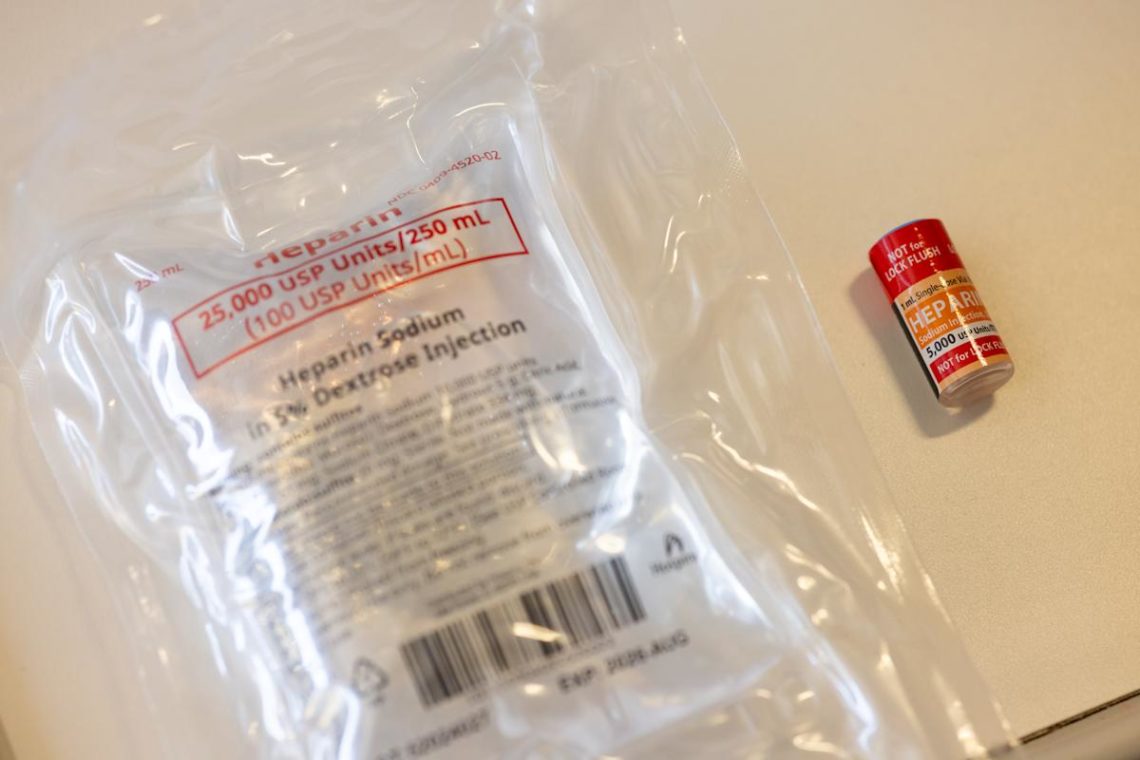BALTIMORE – Thousands of miles from a manufacturing plant in China, where the key active ingredient in heparin is sourced, Wanda Crowell receives a daily infusion of the drug in her bed at Johns Hopkins Hospital.
Doctors give Crowell the inexpensive, essential anticoagulant every day, to prevent life-threatening blood clots from forming in her central line, a plastic tube inserted in her chest that delivers the nutrients she needs to live. A two-time cancer survivor at 66, Crowell has not been able to eat solid food since 2021. She also needs heparin to treat a history of blood clots.
For Crowell, there is no suitable alternative. While other patients may have options, she cannot take oral medications.
“If Wanda’s line is clotted off and we can’t get another line in, she would not get her nutrition,” said Peggy Kraus, a pharmacist on Crowell’s care team. “The drug is essential for her survival.”
The main focus of President Donald Trump’s on-again, off-again tariff campaign has been high-profile industries such as steel, automobiles and consumer electronics. But on Tuesday, Trump warned that another target will soon be the wide variety of medications whose active pharmaceutical ingredients are largely made in China and India.
No one knows how big a tariff is coming or what its effect on generic drugs like Crowell’s heparin may be. But along the supply chain that ends at Crowell’s bedside, many are worried.
Health experts warn that the impact could be felt quickly. Tariffs could disrupt pharmaceutical supply chains, drive up costs for generic drugs and place additional strain on an already burdened health-care system.
The U.S. domestic supply chain is not equipped to meet national heparin demand. Building a self-sufficient supply would require substantial investment in processing infrastructure, a reliable source of animal tissue and regulatory support. Unless that capacity expands, the United States will remain reliant on international suppliers to meet the bulk of its needs.
“There is a chokehold of China on many of those” active ingredients, “so from a geopolitical perspective we’ve been over-relying on China, which has allowed for cheaper prices, but also a greater risk,” said Mark R. Kennedy, a former congressman from Minnesota and the director of the Wahba Institute for Strategic Competition, a research institute in Washington, D.C.
The American Society of Hematology estimates 12 million hospitalized patients use heparin each year. On average, a heparin injection costs 70 cents for a one-milliliter vial, said David Stimler, a pharmacy purchasing administrator at Johns Hopkins Medicine.
The drug is derived from the mucosal lining of pig intestines. China dominates the global market because of its large pig population and processing infrastructure. While countries such as India and Spain also produce the necessary raw materials, trade experts say China’s scale, cost efficiency and streamlined systems make it the preferred source.
“If China retaliates with restrictions on pharmaceutical exports, that would be a serious concern,” said Prashant Yadav, a senior fellow for global health at the Council on Foreign Relations. He said U.S. manufacturers may temporarily avoid shortages if they’ve built up reserves, but those supplies are limited.
“We may only see shortages emerge in a couple of months, once the current” supply of active ingredients is depleted, Yadav said.
Heparin is used in surgeries, dialysis and maintenance of intravenous lines.
“In the scope of patients in the hospital, a few percent are getting antibiotics, but at least 50 to 70 percent of patients are ordered heparin or other related medications to help prevent blood clots,” said Elliott Haut, an administrator in the department of surgery at Johns Hopkins Medicine.
“It’s the mainstay of therapy for thousands of Americans daily,” he added.
Experts say past events offer a preview of future risks. In 2008, a sudden shortage of the raw material used to make heparin was caused by a viral disease in pigs in China. Some suppliers responded by mixing in cheaper, harmful substances, which led to 80 deaths and hundreds of serious side effects in the U.S.
During the coronavirus pandemic, when supply chains were disrupted, access to critical medications was threatened. China is also the leading global supplier of active pharmaceutical ingredients for antibiotics, pain relievers and many other drugs.
Manufacturers cannot simply raise prices to compensate for tariffs because generic drugs are subject to pricing laws. The Hatch-Waxman Act of 1984 encourages competition by allowing multiple manufacturers to produce generics, which keeps prices low. The Medicare Prescription Drug, Improvement and Modernization Act of 2003 further limits how much Medicare can reimburse for such drugs.
“In some markets, manufacturers will be limited in how much of the tariff they can pass on to buyers because of government policies limiting such increases,” said Marta Wosinska, a health economist at the Brookings Institution. “Some may try to cut corners, which in light of cuts at the [Food and Drug Administration] makes me worried about quality. Others may leave the market altogether.”
Producers of drugs with small profit margins are more vulnerable to supply disruption – especially if the drugs are later “finished” domestically, rather than in countries with lower labor costs, such as China, said Justin Schneider, vice president of strategic sourcing at Premier Inc. Premier is one of the largest group purchasing companies for hospitals.
“If these medications are suddenly more expensive, who is going to foot that bill? Because my patients simply cannot survive without these drugs,” Haut said.
So far, health economists and pharmacists say they are not concerned the heparin supply will suddenly disappear. They are worried that any squeeze on the supply could force hospitals to find alternative ways to provide anticoagulation therapy.
But alternatives can pose other complications. Other commonly used anticoagulants, such as warfarin, are not always as effective as heparin because they can take longer to reach the right level in the bloodstream and require frequent blood monitoring. Heparin works quickly and can be easily reversed.
Heparin was first discovered in 1916 by Jay McLean, a second-year medical student at Hopkins. It was initially extracted from animal tissue and later refined for medical use, with pig intestines becoming the primary source. The FDA approved the drug in the 1940s.
Slaughterhouses collect pig intestines, and the mucosa is extracted and sent to processing facilities. It undergoes enzymatic digestion to break down proteins and isolate crude heparin. The crude form is then purified and refined before being tested for potency and contaminants.
Bovine heparin, derived from cow lung or intestinal tissue, was phased out in the late 1990s because of concerns about mad cow disease.
It remains in use in some countries, and in January, before the Trump administration took office, the FDA encouraged the reintroduction of bovine heparin to diversify the drug’s sourcing. It’s unclear whether that move has broad support in the medical community or how quickly new supply chains could be stood up.
In a pinch, hospital pharmacists would be able to make bags of traditionally sourced porcine heparin for intravenous drips, Stimler said. But when products are commercially made, they usually have a longer shelf life and production is more efficient.
Stimler said even if the price of heparin were to slightly increase, the hospital would still purchase the premade vials and intravenous supplies of heparin.
“It’s almost like comparing making your own dinner to takeout. You know it’s going to cost a little more, but it will probably taste better, and you’ll save time,” Stimler said. “It just adds one more thing to the pharmacist’s plate.”
Related Content
Scientists are ‘X-raying’ the Amazon, unlocking a lost human history
The Smithsonian could be the beginning of Trump’s plan to edit history. Or the end.
Pro-Trump creators play down market turmoil: ‘Losing money costs you nothing’
The post Millions in the U.S. take this drug. Tariffs might complicate their care. appeared first on Washington Post.




